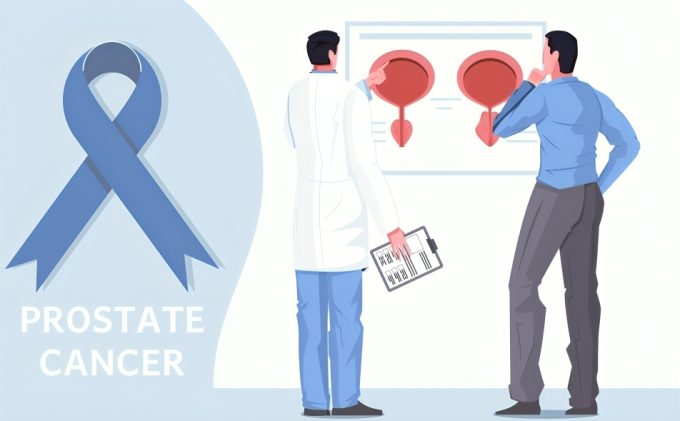Learn what to expect when visiting the Emergency Department. Learn More
-
CALL: +971 4 3454040

- Medical Technology
- June 30, 2025
- 4 MINS READ
Introduction: Mid‑Life, Yet Prime Time
Turning forty often feels like straddling two worlds—youthful energy remains, yet, importantly, new health priorities emerge. Among them, Prostate Health deserves heightened attention because the small, walnut‑sized gland quietly influences urinary flow, reproductive capacity, and overall vitality. Moreover, hormonal shifts, lifestyle strain, and genetic factors begin converging; therefore, men who learn, adapt, and act early enjoy sharper wellness decades down the road.
Why the Prostate Demands Extra Care Now
After 40, testosterone gradually tapers, while dihydrotestosterone may accumulate, and, consequently, prostate cells can enlarge. Although benign prostatic hyperplasia (BPH) is non‑cancerous, it still narrows the urethra and irritates the bladder. Thus, maintaining Prostate Health now reduces sleep‑robbing nocturia, discourages chronic inflammation, and, critically, lowers cancer risk.
Recognizing Early Warning Signs
Because symptoms creep in subtly, men must remain observant; however, many dismiss mild changes until they escalate. Watch for:
-
Frequent night‑time urination, yet low volume
-
Hesitation or weak stream, followed by dribbling
-
Pelvic discomfort, although not overt pain
-
Occasionally, blood‑tinged urine or semen
If any sign persists beyond two weeks, then consultation should follow promptly.
Decoding the Screenings: PSA, DRE, and Beyond
While annual physicals cover basics, proactive men, moreover, request prostate‑specific checks. Since regular evaluations underpin sustainable Prostate Health, consider the following ladder:
-
PSA Blood Test – Measures prostate‑specific antigen. Although levels vary, a sudden rise, especially year‑over‑year, warrants closer imaging.
-
Digital Rectal Exam (DRE) – Despite being brief, a tactile assessment detects asymmetric nodules. Therefore, it complements PSA trends.
-
Multiparametric MRI – Meanwhile, cutting‑edge scans map suspicious zones before biopsy, thereby reducing unnecessary tissue sampling.
Together, these tools provide layered insight, and, consequently, enable tailored action rather than guesswork.
Lifestyle Levers: Small Tweaks, Big Payoffs
Healthy habits fortify Prostate Health far more than dramatic, short‑lived overhauls. Start modestly, yet maintain consistency:
-
Adopt an Antioxidant‑Rich Plate
-
Tomatoes deliver lycopene; furthermore, grilled or sun‑dried forms boost absorption.
-
Cruciferous vegetables—broccoli, kale, and cauliflower—supply sulforaphane; consequently, cellular detox pathways activate.
-
-
Mind the Fat‑Fiber Ratio
-
Omega‑3s from wild salmon, flaxseed, and walnuts fight inflammation, while saturated fats, however, fuel it.
-
Daily soluble fiber improves hormone clearance, thereby lightening prostate load.
-
-
Move with Intention
-
Moderate cardio enhances circulation, yet yoga and Pilates additionally relax pelvic floor tension.
-
High‑intensity sets twice weekly spur metabolic resilience without overtaxing joints.
-
-
Stay Hydrated, But Strategically
-
Sip water steadily through daylight; nevertheless, taper two hours before bed to curb night trips.
-
-
Prioritize Stress Hygiene
-
Chronic cortisol compromises immunity; therefore, meditation, journaling, and brisk walks diffuse pressure quickly.
-
Bullet‑Point Quick Wins
-
Choose green tea over sugary sodas, and reap catechin benefits.
-
Schedule screen breaks hourly; prolonged sitting compresses pelvic tissues.
-
Track bathroom patterns via a simple phone note, thus spotting trends early.
Medical Interventions: From Medication to Robotics
Even with disciplined living, some men progress toward BPH or malignancy. Fortunately, modern therapy lines have broadened; thus, fear need not delay decisions.
-
Alpha-blockers relieve urinary tension within days, although dizziness can occur initially.
-
5‑Alpha‑Reductase Inhibitors shrink gland size gradually; consequently, many avoid surgery altogether.
-
Minimally Invasive Techniques—such as UroLift, Rezūm steam, or plasma ablation—offer fast recovery and preserve sexual function.
-
Robotic‑Assisted Prostatectomy uses 3‑D magnification and wristed instruments, therefore enhancing precision and shortening hospital stays.
Continual technological evolution means tomorrow’s options will be, undoubtedly, even gentler.
Conclusion: Charting the Road Ahead
Ultimately, safeguarding Prostate Health hinges on timely knowledge, disciplined habits, and trustworthy medical alliances. While global guidelines provide a compass, regional expertise refines direction; hence, seasoned urologists in Dubai blend global research with local epidemiology for optimal outcomes. Furthermore, an annual dialogue with the multidisciplinary team at Medical Specialists Center cements a personalized roadmap—one that balances vigilance with peace of mind, ensuring men stride confidently through their forties, fifties, and beyond.



